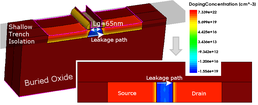Modelling the Combined Effects of Total Ionizing Dose and Random Dopant Fluctuations in sub-100 nm gate-length Transistors
- Started
- 1st October 2012
- Ended
- 30th September 2015
- Research Team
- Eleni Chatzikyriakou
- Investigators
- Kees de Groot

Leakage paths created from charges gathered at the buried oxide and shallow trench isolation oxides as a result of ionizing radiation
Electronic circuits and devices in radiation environments undergo significant challenges as their operation can be impeded by incident particles. Hardening electronics against radiation is required for aerospace as well as particle physics research applications.
One of the vulnerable aspects of electronic components today lies in the use of dielectric materials which when irradiated gradually degrade. The goal of this project is to examine the radiation tolerance related to the dielectric structures of state-of-the-art CMOS technologies produced by the industry using TCAD simulation tools.
The high body doping incorporated into commercial CMOS technologies dictated by the scaling needs suggests a high tolerance against radiation. This stems from the fact that, under these conditions, parasitic transistors are not formed as easily, reducing leakage current and unwanted reversal of the transistor state to ‘ON’. However, for these technologies to be used in a radiation environment we need to be sure that small variations in their doping densities, that otherwise pass undetected under normal operation, will not pose a problem after ionization of their oxides. These variations cannot easily be examined through experimental means, as we need a large number of devices in order to have a meaningful sample.
With the use of the Iridis supercomputer, we can perform computationally-intensive 3D simulations of transistors with a large number of doping variations and configurations. This will allow us to measure the statistical variability of the radiation-hardness in commercial transistors and potentially reveal inherently radiation-hardened devices that need no special processing steps to be used in radiation environments.
Categories
Physical Systems and Engineering simulation: Electromagnetism, Semiconductors
Algorithms and computational methods: Finite elements
Simulation software: Sentaurus TCAD
Programming languages and libraries: Mathematica, Matlab, MPI, Tcl